Since human prehistory, we have long relied on the plant kingdom to heal, protect, and nourish: “biophilia” refers to humanity’s innate tendency to seek connections with nature and other forms of life. In nearly every industry, architects, artists, designers, gardeners, poets, and scientists alike have long been inspired by nature. To achieve balanced ecological performance, designers, artists, and architects alike are turning to biologists for their expertise and guidance. Today there are a surprising multitude of different ways design, art, production, and architecture have examined the nexus of nature and technology. They are engaging with nature in innovative and ground-breaking ways, driven by a profound awareness of climate change and ecological crises as much as advances in science and technology. In a contemporary world seeking to design and manufacture with fewer materials and lessen its carbon footprint, no better model exists than in the natural world, where biological functions have evolved for efficiency down to macroscale. “Biodesign” incorporates living organisms into design as support structures, material sources, energy generators, security measures, or air purifiers, just to name a few examples. Bio-design refers to incorporating living organisms as an essential component and enhancing the product quality. It goes beyond mimicry to integration, minimizing the separation between biology and technology and creates new hybrid technology in design. Landscape urbanism and other models of “Green urbanism” can fall under this category.
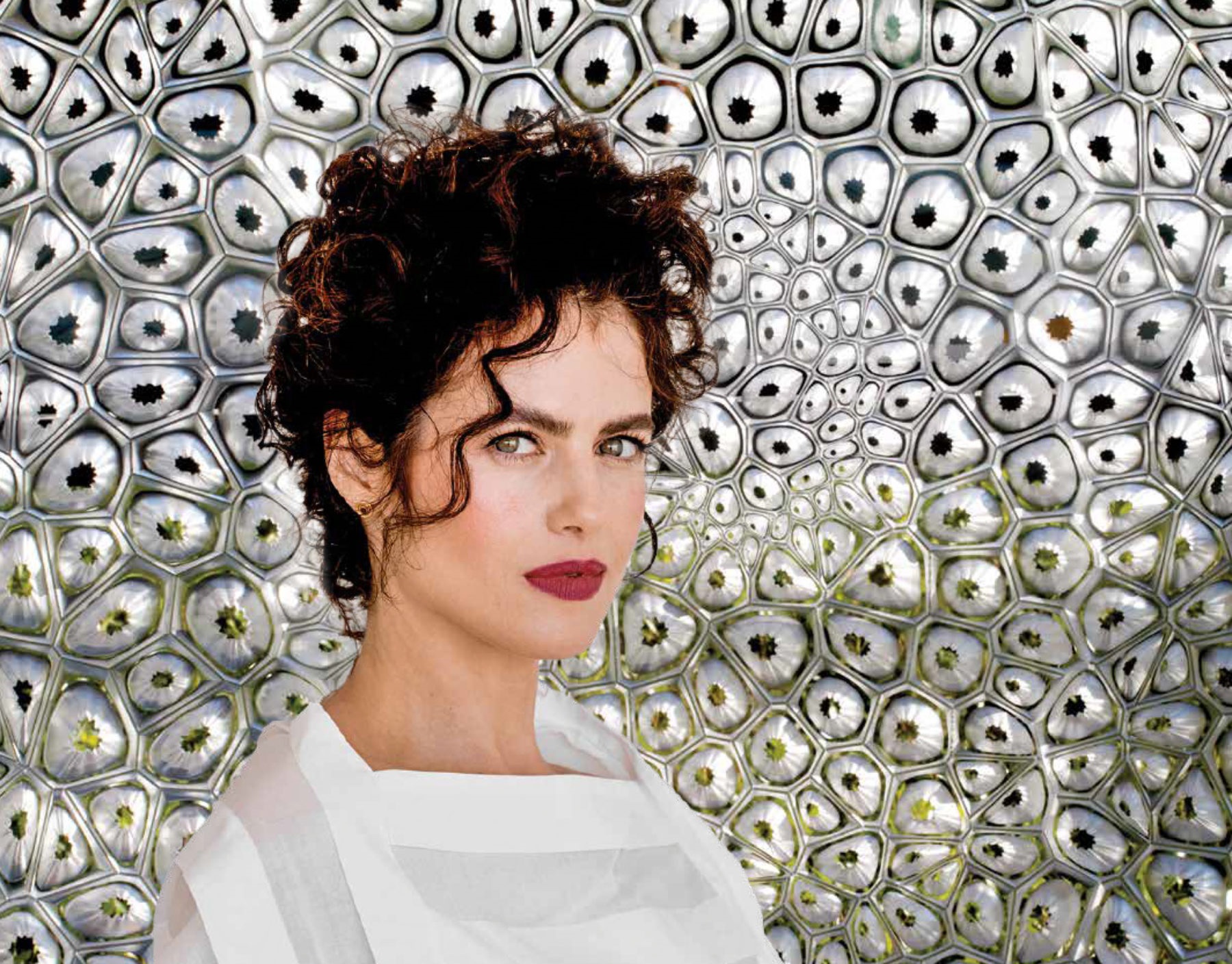
Dr. Neri Oxman, American–Israeli designer and professor at the MIT Media Lab, where she leads the Mediated Matter research group.
Designer, architect, and MIT professor Neri Oxman is leading the search for ways in which digital fabrication technologies can interact with the biological world. Oxman is well-known for her unique biomimetic philosophy, operating “between the chisel and gene, moving away from the assembly line.” Leading the MIT Media Lab, she heads groundbreaking research in materials, buildings and construction processes. The breadth of Oxman’s work comfortably straddles the realms of architecture, design, science, and invention. In fact, she has coined the term “Material Ecology” to describe her approach, fusing organic design, material science and digital fabrication technology to produce new techniques and objects informed by nature. How can we 3D print, for example, in a way that moves away from assembly and instead mimics natural growth? Through computational codes and materials engineering can we edit DNA to create new biological functionality and structures that only nature knew how to design, creating structures that could augment living matter?
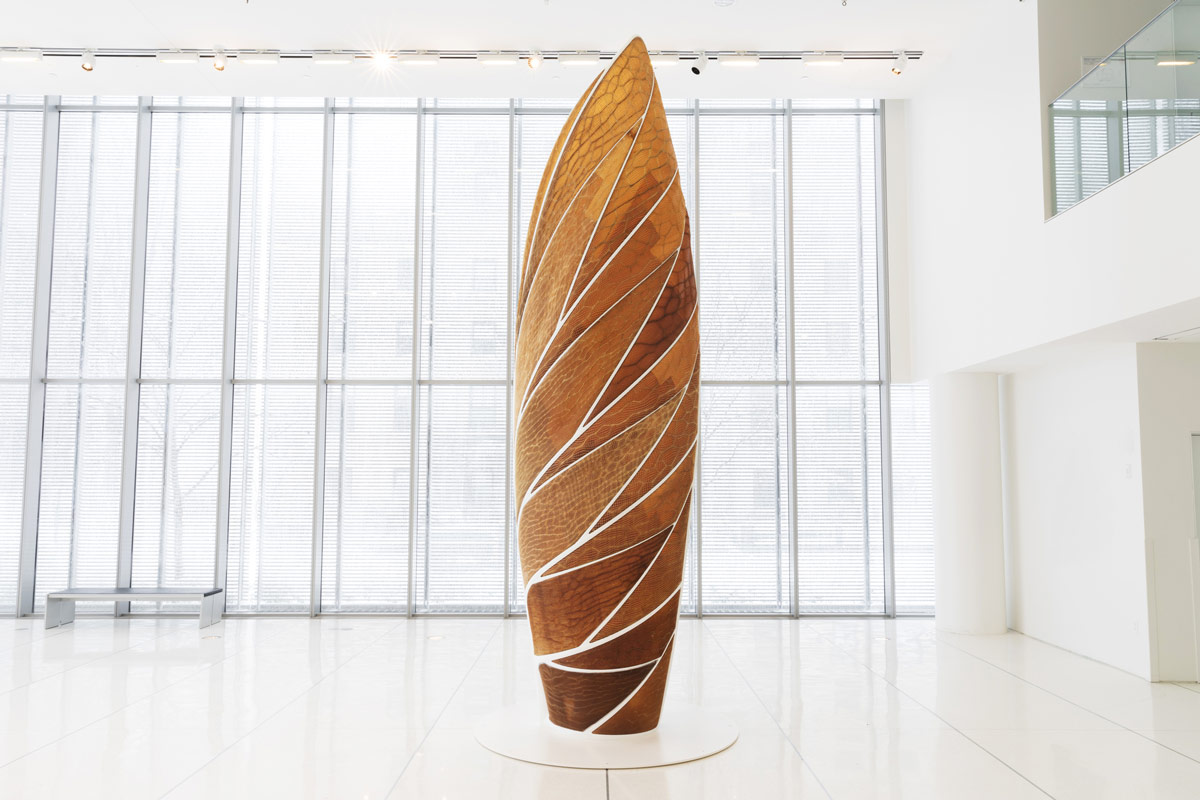
Neri Oxman’s project pictured, named Aguahoja (2018), is a composite of bio-programmable natural materials like cellulose, chitosan, and pectin, generating geometric patterns through design input algorithms. Here it is displayed at the San Francisco Museum of Modern Art.

Oxman and Iris Van Herpen’s Anthozoa 3D-printed skirt and cape, part of the collection of VOLTAGE garments.
Some of the most dramatic articulations of Oxman’s research includes a garment collection in collaboration with Dutch designer Iris Van Herpen: the VOLTAGE collection of 3D-printed garments, where delicate hand-made embroidery and needlework is replaced by code. One garment mapped physical movement and material behaviour to geometrical form and morphological variation in a completely seamless garment.
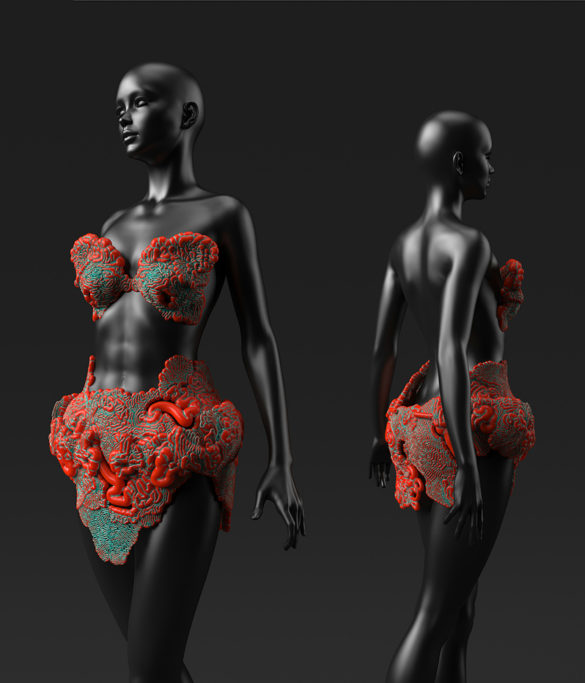
Oxman’s photosynthetic wearable garment, whose colored channels indicate the capacity to host microorganisms.
Oxman’s other fashion-forward projects include photosynthetic “wearable skins,” composed of hollow channels housing photosynthetic cyanobacteria and E. coli, that glow fluorescent bright colors in the darkness and producing biofuels with exposure to the sun. The wearable structures in the collection were designed to facilitate synthetic biological processes that might one day allow humans to travel to and survive on other planets. Discussing the projects, Oxman states that “in the end, it is clear that the incorporation of synthetic biology in 3D-printed products for wearable microbiomes will enable the transition from designs that are inspired by nature, to designs made with and by nature, to, possibly designing nature herself.” These acts of “liquid alchemy,” Neri states, acknowledge nature as the ultimate designer. “How poetic our reality has become!” she declares.
However, no project of Oxman’s is a better example of nature and humanity as co-fabricators than robots and silkworms working together to weave, exploring how digital and biological techniques can come together to produce architectural forms. We’re talking about the Silk Pavilion by Neri Oxman and the MIT Media Lab, a project inspired by the silkworm’s ability to generate 3D cocoons out of a single multi-property silk thread. For this project, the team programmed a CNC robotic arm to imitate the way a silkworm deposits its silk in cocoons, laying down silk threads across 26 polygonal panels. The scaffold of panels were arranged into a dome and suspended from the ceiling. Then, 6,500 silkworms were fed and deposited onto the structure, and with the team’s careful consideration of sunlight and other climate factors affecting silkworm weaving, they spun across the CNC-deposited fibers to complete the structure. The team attached tiny sensors to the heads of silkworks so that they could motion-track their movements. They were then able to feed this data into their 3D-printer connected to a robotic arm in an act of mimicry. Oxman believes that by studying natural processes such as the way silkworms build their cocoons, scientists can develop ways of printing architectural structures more efficiently than can be achieved by current 3D printing technologies.

Lonneke Gordijn and Ralph Nauta, founders of studio DRIFT.
The arts have always taken cues from the natural world, and today contemporary art collectives and studios are creating work that is increasingly technological and ecological in creation. Take, for instance, studio DRIFT: an Amsterdam-based artist duo founded in 2007 by Ralph Nauta and Lonneke Gordijn, who attended the Design Academy Eindhoven together. DRIFT specializes in choreographed sculptures and kinetic installations, with the focus to re-establish the connection between humans and earth. Their biography states:
“DRIFT manifests the phenomena and hidden properties of nature with the use of technology in order to learn from the Earth’s underlying mechanisms and to re-establish our connection to it.”
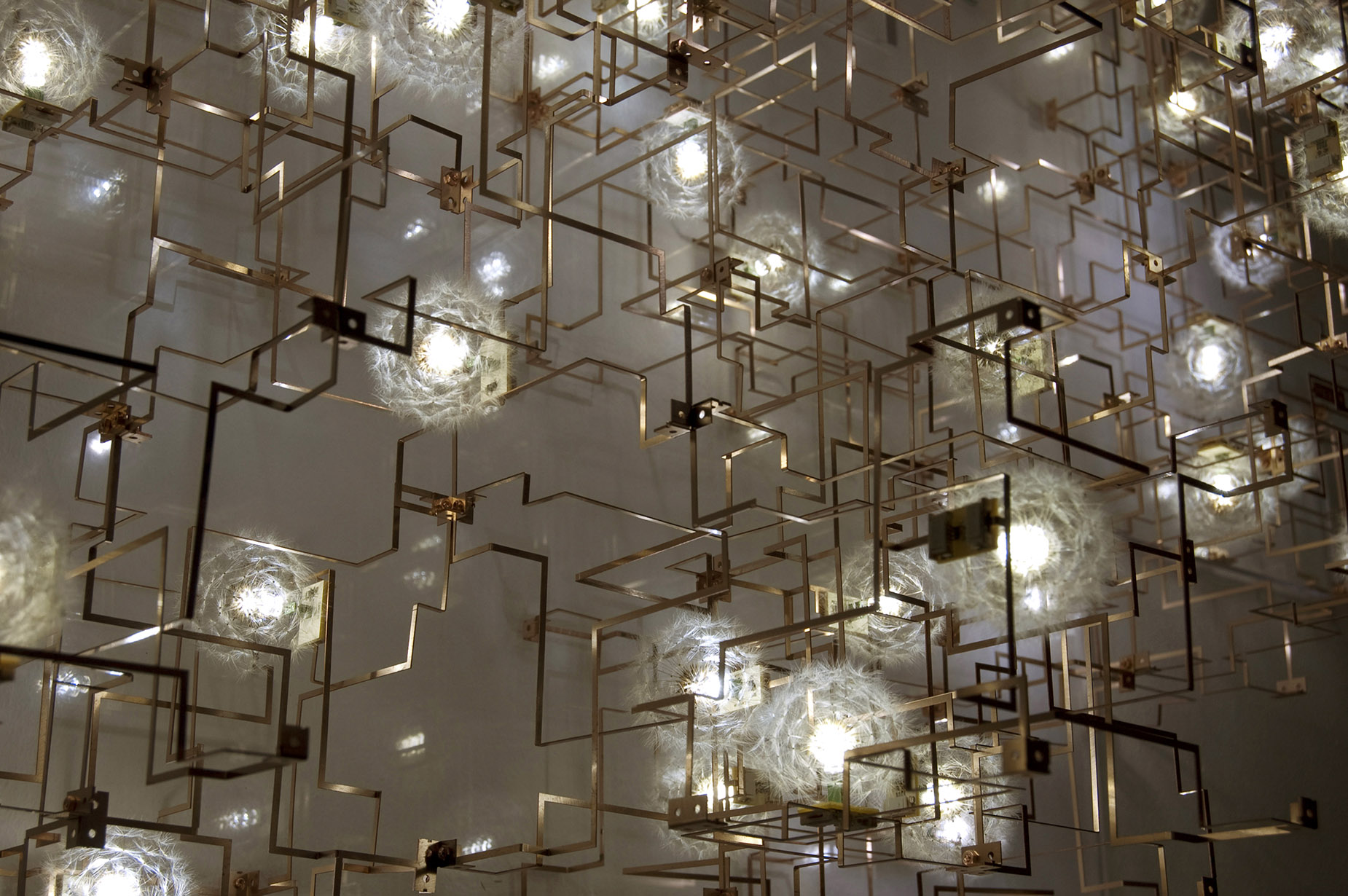
Detail view of Fragile Feature, showcasing the size and number of the individual seeds of the dandelion attached to LED lights.
Inspired by nature both philosophically and in their formal practice, their work explores the relationship between nature, technology and mankind through a process involving collaborations with scientists, university departments, research facilities, programmers and engineers. They first collaborated on Gordijn’s graduation project, Fragile Future, a number of ball-shaped LED lamps with real dandelion seeds glued onto them, giving the bulbs a flowerlike appearance. You can read more on this project and specifically on DRIFT in our article Studio Drift: the Synergy Between Nature and Technology.
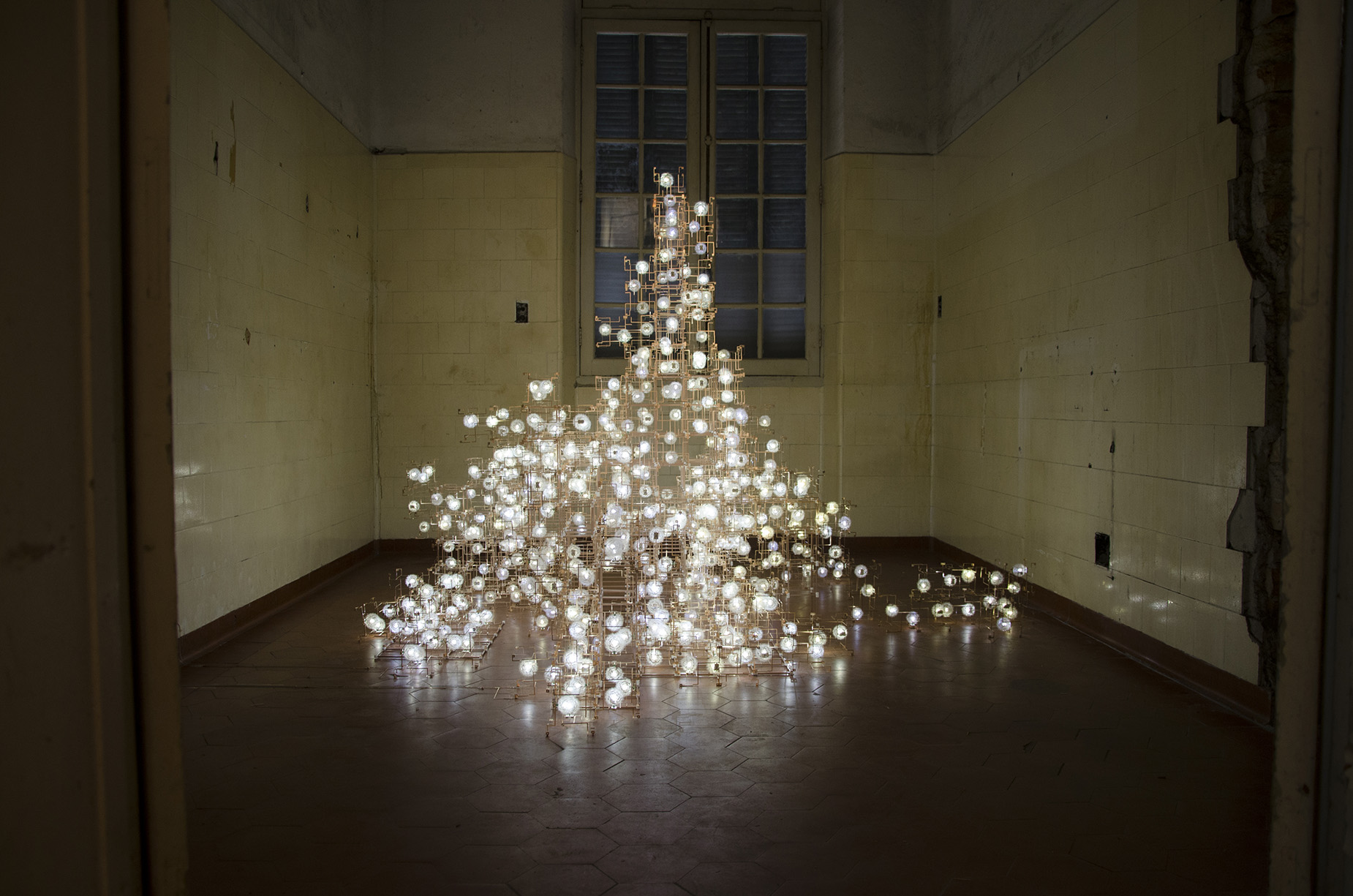
The structures comprising Fragile Future can be assembled into various shapes and forms to suit their environment. In each new location it is displayed in, Fragile Feature typically takes on a different appearance.
“Fragile Future was my graduation project. I was never really interested in making functional objects. Moreover, I wanted to understand what level of awareness of humanity or the environment an object could raise. Fragile Future uses the fragility of dandelion seeds as a strength and poses its ability to make a meaningful connection with a completely different human system… It was a total coincidence that one day I picked a dandelion from my garden and discovered its head has exactly the same size as an LED light bulb. I glued, one by one, the parachute seeds with tweezers on the LED and immediately knew this meant much more than only making a beautiful image. Connecting electronic circuits with natural components was the first step toward the later development of our works, where we aim to reestablish the connection between humankind and the earth.” – Gordijn

Franchise Freedom rendering for New York Times.
Naturally, AI and computer programming became technological tools for DRIFT to deepen their explorations of biomimicry and the human condition. One of their largest and oft-performed pieces is titled Franchise Freedom. In it, a swarm of 300 drones, each with their own light source, are individually controlled by a computer algorithm: a complex formula that created from studies of the natural flocking behavior of birds, which changes when one of the parameters changes, resulting in a performance “that mimics what you can see in real birds in the sky, or fish in the sea,” Gordijn said. Through the flight behavior of birds, Franchise Freedom makes a poignant statement about our perceived freedom, as the “flock mind” speaks to our ultimate social ties and pressures as a species. The piece has flown over such major events as Miami Art Basel and Burning Man Festival.

Franchise Freedom taking flight over Burning Man festival in September 2018.

Nevi Pana’s sodium-covered stool, scaffolded and lifted from the Dead Sea.
Israeli designer Erez Nevi Pana was raised on a plant nursery and spent his childhood in family greenhouses. With this upbringing, Nevi Pana makes bold declarations in design. He is known for his experiments with plant and mineral matter to create animal-free furniture, introducing veganism with new force into the design industry. Having adopted a vegan lifestyle himself as a form of activism, Nevi Pana is pushing designers to follow in a vegan practice to help solve the major environmental issues facing today’s world and combat climate change.
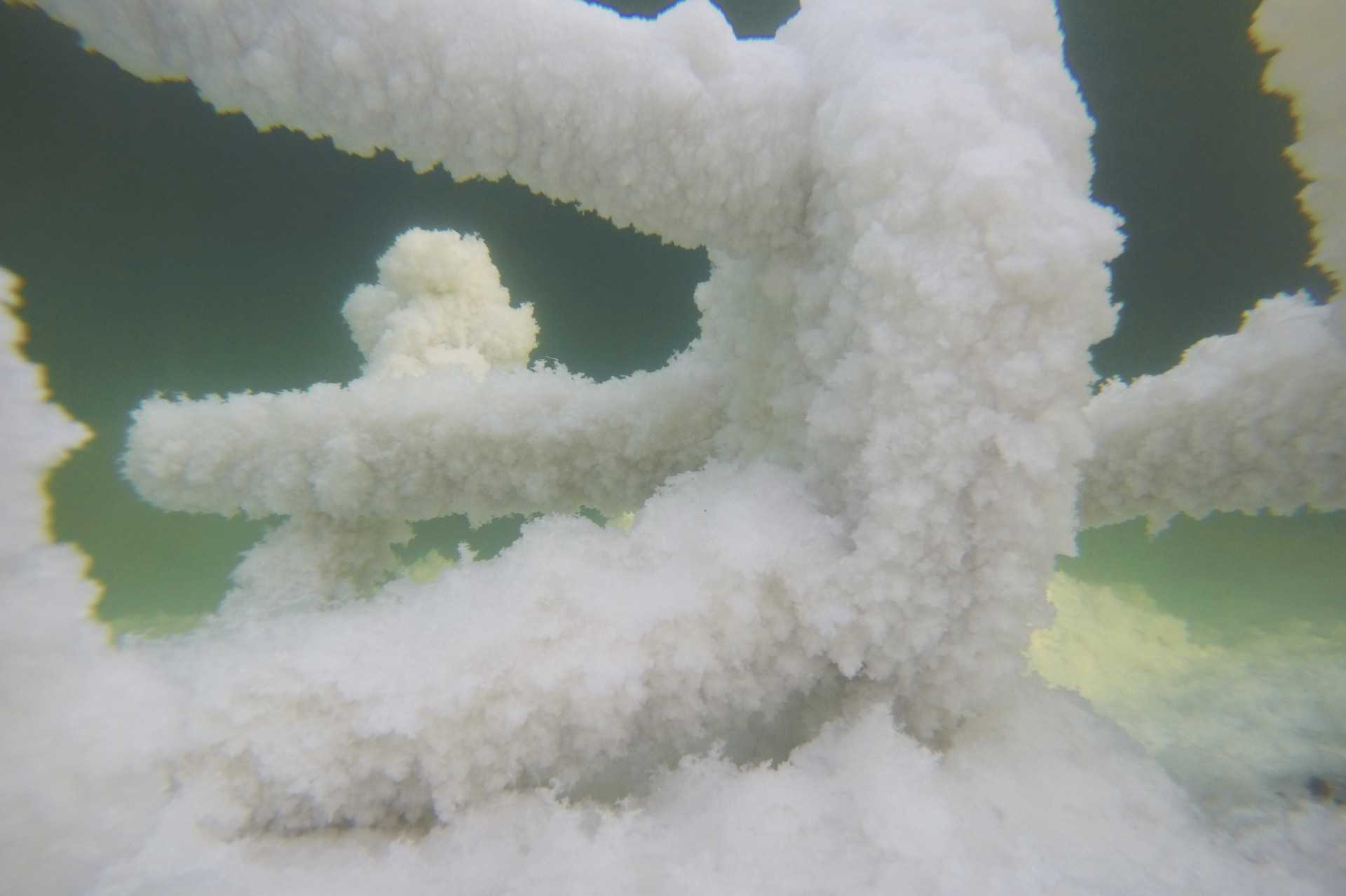
Nevi Pana’s “Bleached” series salt exploration imagines a possible constructive outcome from humanity’s interference with nature.
After graduating from the Design Academy Eindhoven, Nevi Pana sought to build on his PhD research to see if it was possible to make beautiful objects without using any kind of material derived from animals, what he calls “free from guilt,” designs, by experimenting with natural resources and processes. He began his explorations into vegan design with the Dead Sea – the result of several years of investigation into the material applications of salt, Nevi Pana utilized the Dead Sea’s sodium-heavy water to create salt-covered seating. Motivated by destructive mineral extractions in the Dead Sea, Nevi Pana’s Bleached series of salt stools imagines a constructive outcome from humanity’s interventions with nature. The stools remarkably require little of a human hand: Nevi Pana submerges wooden skeletons encased in loofah into the Dead Sea, leaving them to crystallize like coral formations. Nature and time do all the rest, to create design pieces that are ornate and yet simplistic.
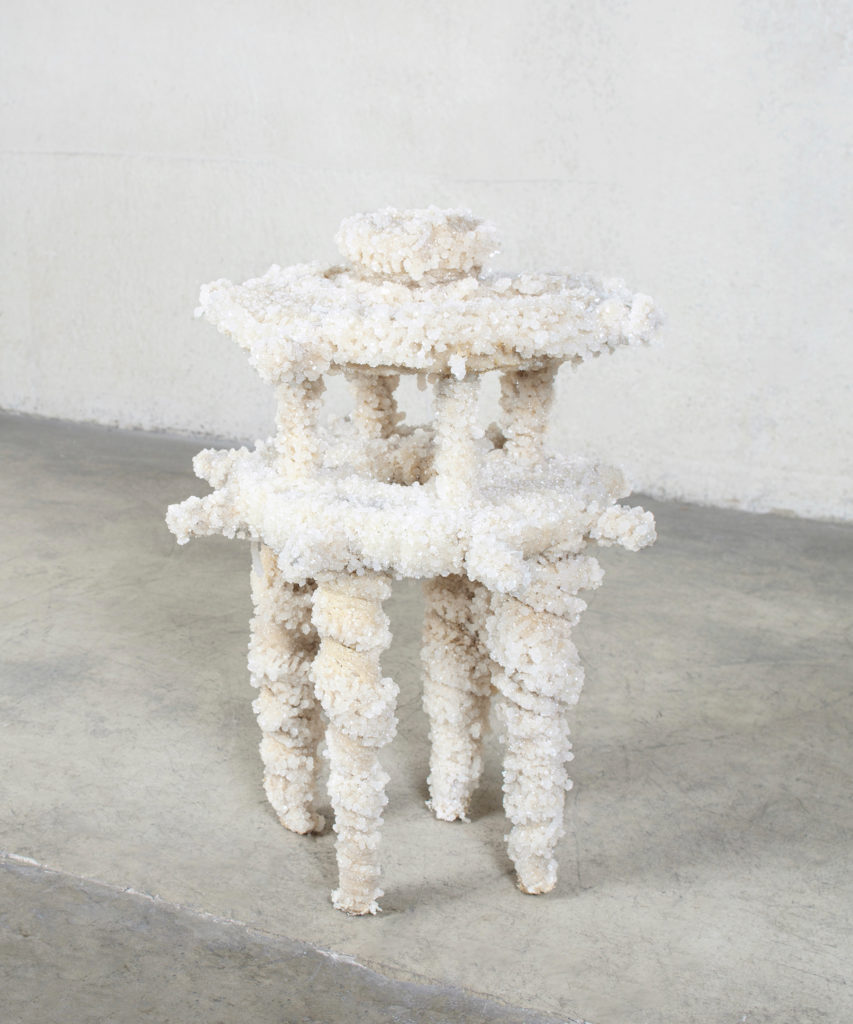
Erez Nevi Pana, Bleached (III), 2018. Salt crystallized loofah over a wooden structure.
Further exploration for Nevi Pana includes a remarkable dough made from soil and fungus that can be baked: perhaps the ultimate in affordable, accessible, and environmentally-friendly materials. The mixture rises like bread dough due to biochemical reactions and can then be shaped using plaster or wooden moulds. The resulting object solidifies strong enough to hold human weight, and can then be sanded, sawed, and drilled to shape.

Nevi Pana first began experimenting with soil as a material for producing affordable and sustainable products during his studies at Design Academy Eindhoven.
In the realm of textiles, Nevi Pana designed a series Unravel, of what he calls Ahimsa Silks or “peace silks.” While traditional silk manufacturing techniques involve the eventual death of the silkworms, Nevi Pana’s silks harvest silk cocoons only once they are vacant and the pupae have metamorphosed, allowing them to live on as moths. For the Unravel tapestries, Nevi Pana unravels the silk cocoons as well as straw baskets he takes from inhumane silk manufacturers, uniting them into one. Pana attributes his fascination with textiles to his Middle Eastern ancestors, who were yarn traders in the Indian village of NabiPanah (the origin of Nevi Pana’s surname). Nevi Pana has shown his work in exhibitions internationally while he continues honing his clear design ethic and bold exploration of sustainable materials, giving the most common and basic organic elements a newfound ornamental value.

The cruelty-free Ahimsa Silks were displayed as part of Nevi Pana’s exhibition “Consciousness” at Friedman Benda in 2018. “For me, in suffering we are all equal — it is not a matter of scale,” he stated of the silks.
Imagine if beyond simply utilizing organic materials, architects could create buildings that were actually alive, a living architecture of sorts, grown and maintained by live cellular organisms? What if microorganisms in a face shield could glow warning colors when exposed to toxic chemicals, or a vase holding flowers could fertilize, change color according to the flowers’ lifecycle, and help in biodegrading after the contents has withered? Oxman coined the term “material ecology” to describe new bio-based materials being engineered to meet specific human needs and lessen the environmental impacts of manufacturing.
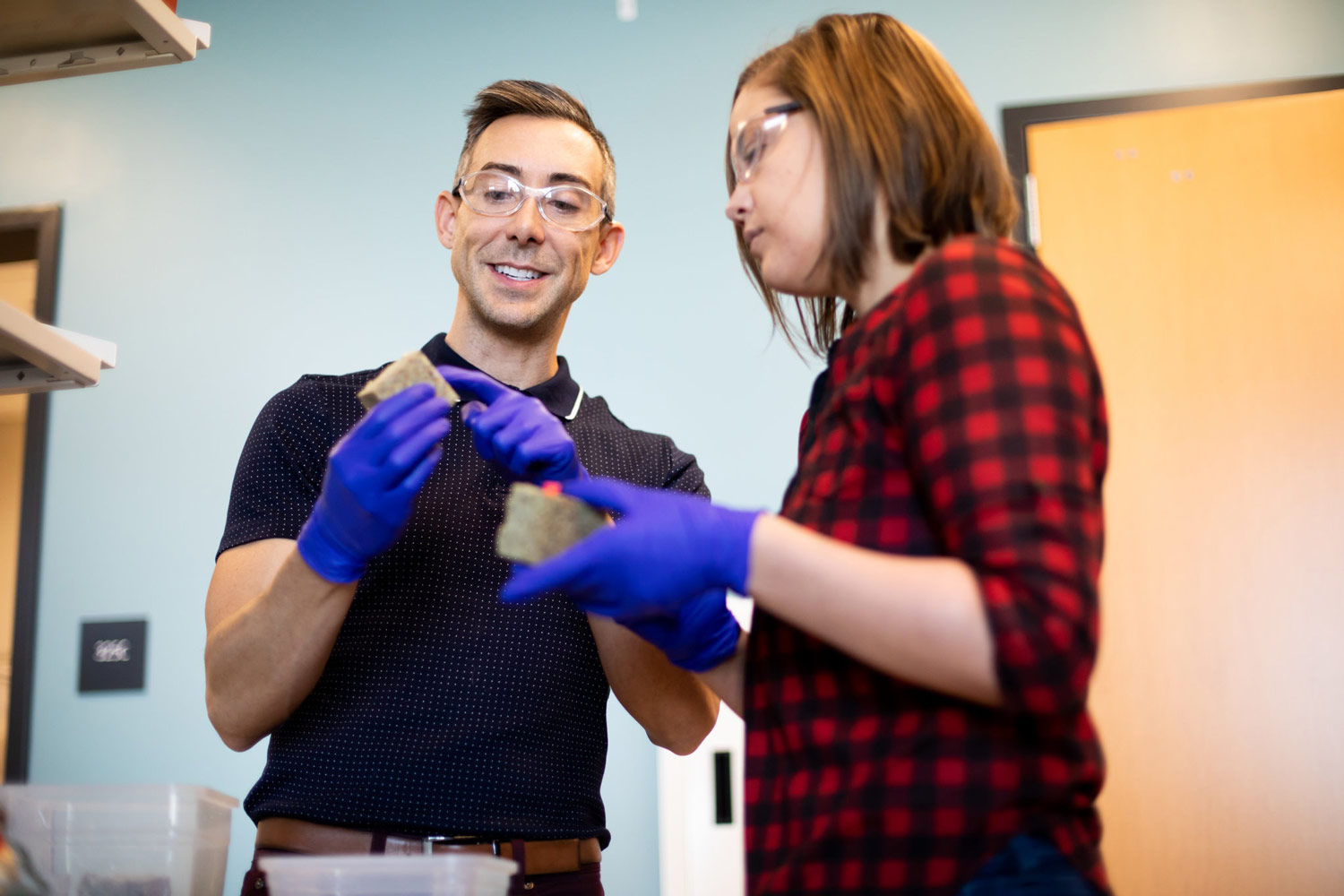
Dr. Wil Srubar (left) a structural engineer at the University of Colorado, Boulder, and materials science and engineering PhD student, Sarah Williams, holding bricks of building matter made from cyanobacteria and other materials.
Like the interconnected biological web, the scope of bio-materials is considering sustainability in multiple directions. Dr. Wil Srubar––Assistant Professor of living materials at University of Colorado, Boulder––has described breakthroughs in DNA manipulation and synthetic biology, engineering bacteria to create useful minerals and polymers to form living building blocks, like microscopic factories. In several studies, he and his team at Boulder’s Living Materials Laboratory were able to genetically programmed E. coli to create limestone particles as well as styrofoam, with different shapes, sizes, stiffnesses and toughness. Their most recent work, however, goes a step further to create green cells for green building: photosynthetic cyanobacteria using CO2 and sunlight create a bio-cement, binding particles together to create a living brick. By keeping the cyanobacteria alive, the team is able to grow a new structural building material exponentially. And where traditional building materials like cement emit a tremendous amount of CO2 to create, the new living materials actually absorb CO2, making them environmentally beneficial.
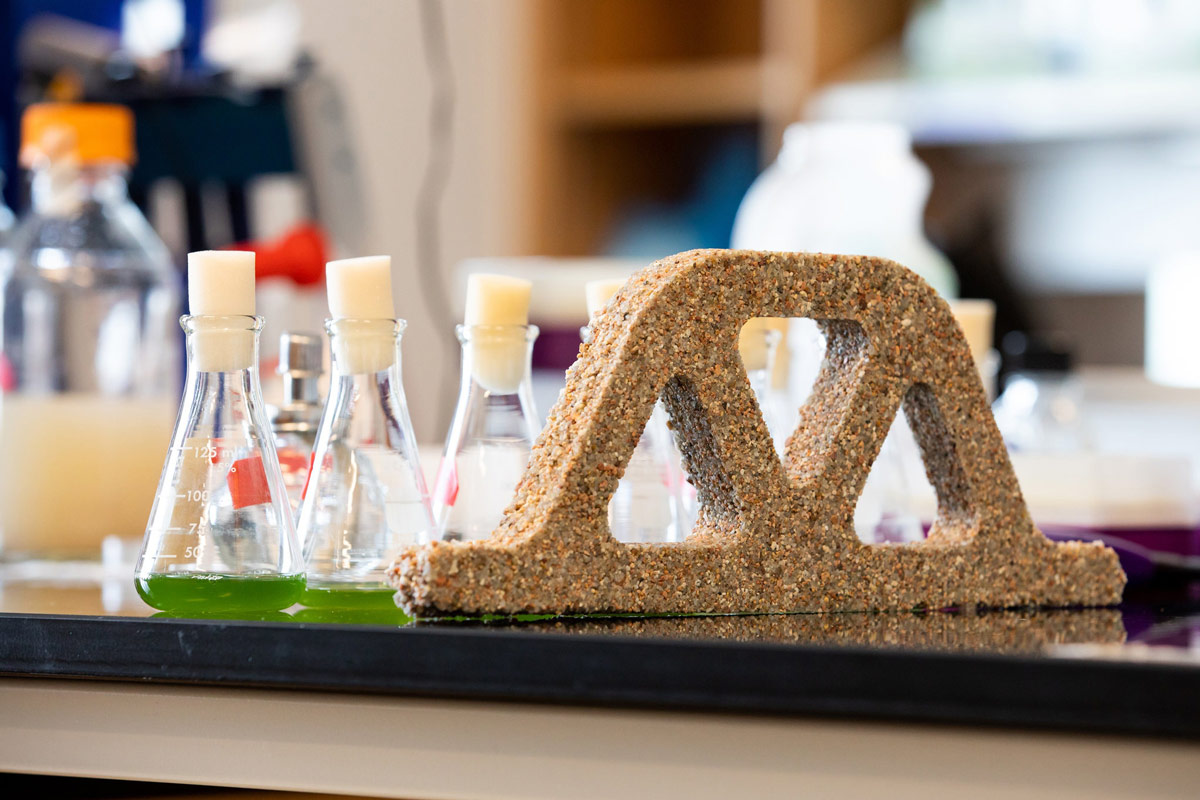
CU Boulder College of Engineering & Applied Science.

Beyer used a custom circular hand-loom to create and house the 160 centimetre-tall cylindrical textile during its calcification.
However, this is far from the only instance of the unlikely human-bacteria creative duo. Reflecting on an ancient history of weaving, London-based architect and designer Bastian Bayer has developed a method of utilizing bacteria to calcify knitted textiles into a sustainable building material. The experiment utilized a cylindrical custom hand-loom to handcraft a soft column made of jute fibre and permeable polyester: both environmentally friendly, sustainable textiles. Then the finished structure was placed in a bioreactor and sprayed with a solution of bacteria called sporosarcina pasteurii. Gradually, the fed active microbiome of bacteria transformed the internal microstructure of the knit material, by depositing microscopic calcite layers in between the fibres, continuously bonding them together over a period of three days. Bayer and fellow collaborator Daniel Suarez hope that the resulting material could have a use in architectural design and construction: as spatial dividers, shading features, reinforcement and potentially structural roof or wall systems.
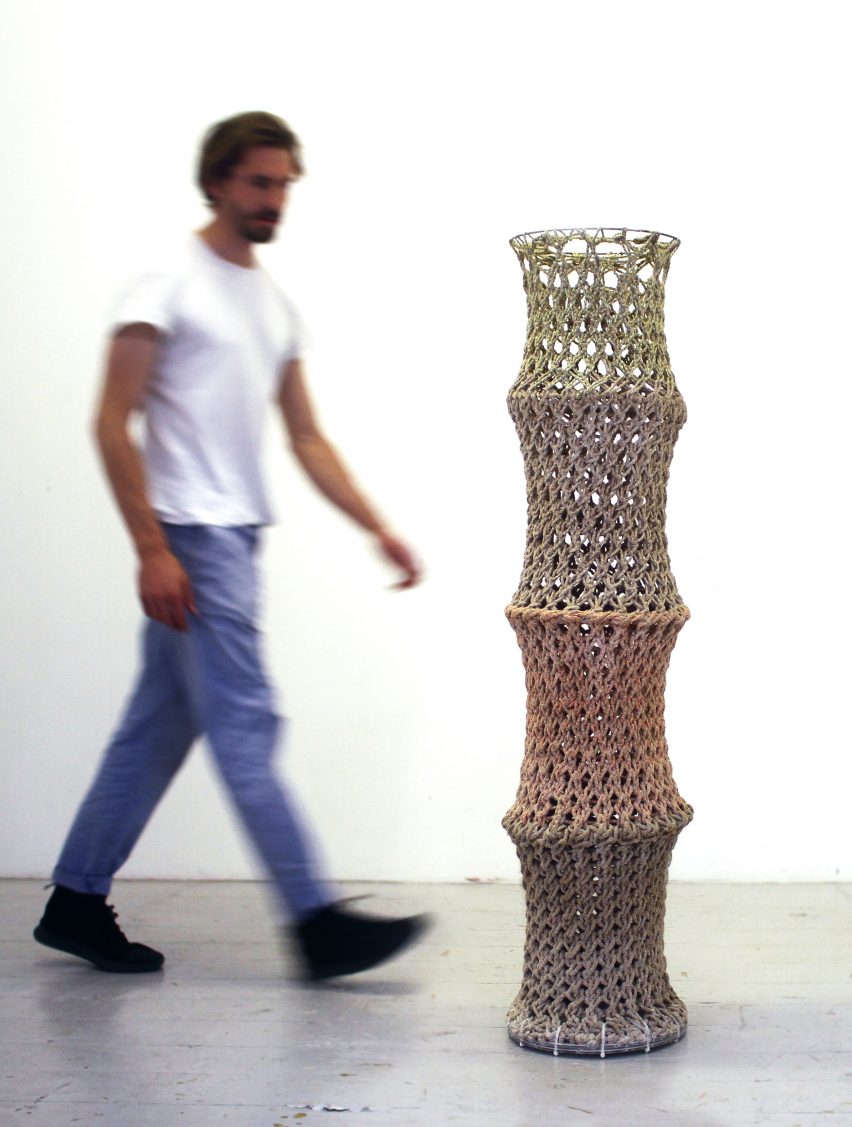
The free-standing calcified textile column, made from jute fibers and porous polyester.
Promoting biodiversity in urban settings is a huge facet of sustainable architecture. Enter the Green Charcoal brick, made from soil, cement, charcoal and organic luffa fibres on the surface of which plant and insect life can thrive. Developed by researchers at the Indian School of Design and Innovation in Mumbai, Green Charcoal bricks harness a fibrous loofah network of air pockets internally, which allow them to harbor biological life. The highly-performative new material is structurally supportive and requires no metal infrastructure, while the charcoal serves as an air purification system. And as a highly porous building material, the bricks are able to reduce their temperature and create a cooling effect for interior environments: quite literally a building that breathes. The research team sees the bricks as an extension of the human-nature connection, and a creation of biophilic design.
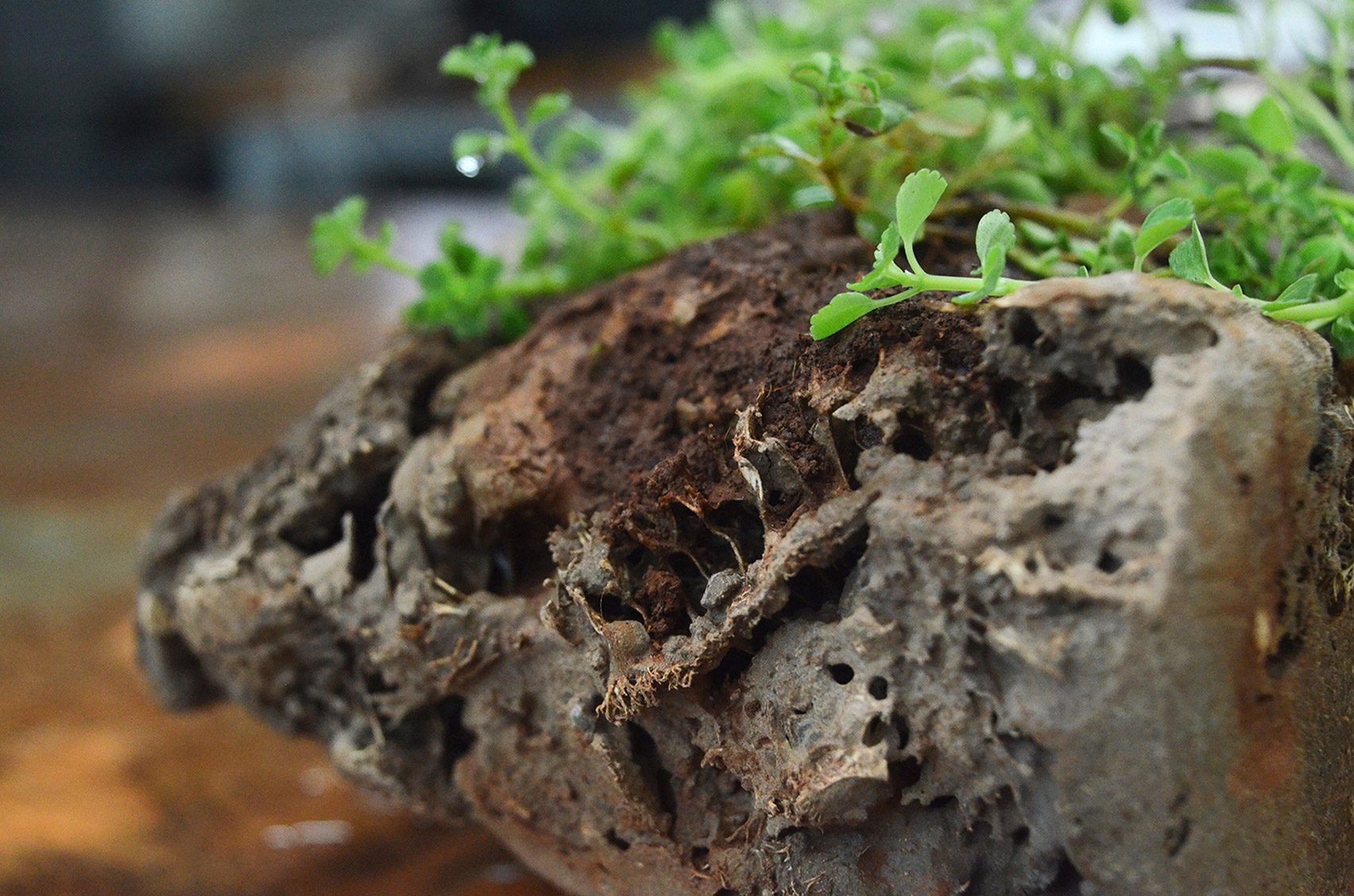
Green Charcoal bricks are 20 times more porous than standard bricks, thanks to their luffa substructure, which also allows it to foster organic life.
“This is aimed at creating a breathing state of architecture to ensure increased biodiversity in cities while providing healthy urban solutions for people,” said project lead Shreyas More. “In biophilic spaces, people are happier, patients recover faster, students learn better, retail sales are higher, workplace productivity goes up, and absenteeism goes down.”
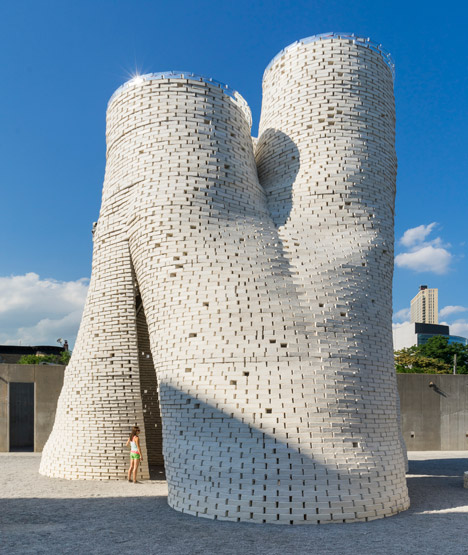
Hy-Fi pavillion in the MoMA Ps1 courtyard, which hosted its Warm-Up summer music series.
In a similar vein, New York-based architecture studio The Living won MoMA PS1’s Young Architects competition to construct a pavilion for their summer events. Their submission is titled Hy-Fi, and stands tall as a microclimate tower made of bricks grown from corn stalks and mushrooms. The structure is entirely biodegradable, with each brick grown rather than manufactured, using a combination of agricultural byproducts and mushroom mycelium as a digestive glue. The cultivated bricks were then coated with a light-refracting film and stacked to bounce light inside the structure, as well as drawing in cool air. MoMA PS1 described the project in a statement: “Hy-Fi offers shade, colour, light, views, and a futuristic experience that is refreshing, thought-provoking, and full of wonder and optimism.”

The interior of the Hy-Fi structure, constructed to allow hot air to rise through the narrow chimneys and create an interior cooling effect.
Indeed, “acts of optimism” are a fitting way to frame the research that today’s creatives are pursuing. Across multiple disciplines, they face common challenges that their predecessors did not: sensitivity to the complexities and conditions of our planet, challenged to lessen humanity’s environmental impact and reliance on nonrenewable resources. Now more than ever, innovators are observing the natural world around them, seeking to forge meaningful connections with nature, inspired by its processes and properties. The days of “Man versus Nature” are waning, as we’ve found that human development works best in collaboration with nature. In ways both small and large, we look optimistically to the natural world for inspiration, as a guide and partner.



















